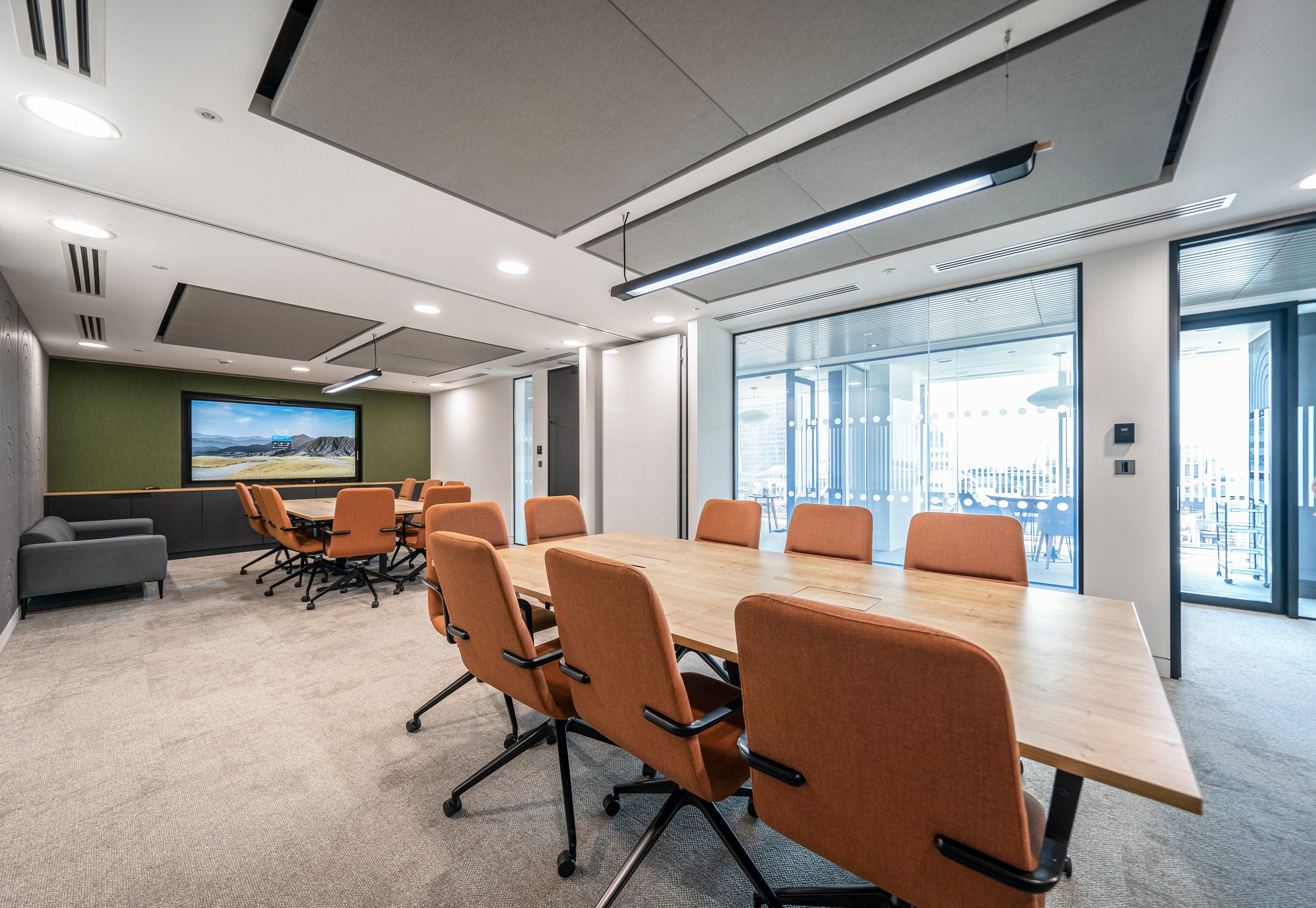The Golden Rules of Workplace Design Consultancy
What are the essential golden rules for interpreting client needs, designing adaptable spaces, and improving employee well-being?


Written by
Fritha Selwyn Jones
Contents
In workplace design, we want to offer a bespoke experience because every business is different. We firmly believe that the key to success is identifying each business's unique vision. That said, there are some rules we consistently follow, some tried and trusted approaches, and some industry standards that all workplace designs benefit from.
We always aim to design resilient environments that balance client requirements with employee wellness and sustainable practices. The golden rules we follow are our roadmap to creating spaces that hit these objectives every time we embark on a project.
Understanding and Interpreting Client Needs
Active Listening & Proactive Approach
The foundation of any successful workplace design project is the client's vision, objectives, and requirements. It’s vital that we actively listen to and engage with clients’ needs and ideas and communicate with individuals across the whole of the company. This means not only owners but workers who use the space, too. This stage of the process is vital for getting an authentic feel for the business, brand, work culture, and current strengths and weaknesses of the space.
A balance of professional guidance is really important in any project. This is a balance of guidance from the client on their brand-specific and industry-specific needs and guidance from the consultant on the best choice and direction to take for the project's benefit. Consultants should maintain a proactive approach, keeping the client informed at every stage and refining designs based on continual feedback, so a dedicated project manager is expected to manage the project throughout. Tailoring the workspace design to client needs, especially in competitive sectors, ensures not only functionality but also enhances brand identity through design.
Objective Assessment of the Space
It’s important to carry out quantitative and qualitative analyses that provide detailed and objective information about the space. These tools help us build a picture of the ideal end result—one that is backed by data.
Gathering data about the client’s needs and perception of their current situation is part of our wider workplace assessment. This is a pretty standard practice in workplace design consultancy and a good golden rule of thumb in the early stages. Effective questioning will often reveal underlying challenges the client may not be aware of, ensuring that the design solutions provided truly align with their needs.
A workplace assessment involves evaluating the current office layout, identifying productivity challenges, analysing space use, and gathering feedback from different individuals who use the space. During our workplace assessment, we’ll look not only at areas for improvement but also at elements of the space that employees enjoy that we want to retain and translate into the new design.
Having gathered details about the space, we may carry out a feasibility study. This focuses on determining the viability of a certain design concept, looking particularly at practicality, space usage, cost analysis, and potential pitfalls. A feasibility study helps us confirm we’re making decisions that will realistically benefit the client.

Creating Adaptive and Resilient Spaces
Design for Adaptability and Longevity
The business landscape is fast-paced and ever-changing, so workplaces must be able to respond and meet these constantly evolving demands. How do we design for the future, knowing a business can change dramatically and quickly?
Flexible, multifunctional, and modular spaces are the answer. This means we create a design that has the transformation potential to adapt to new ways of working, new team sizes, new projects, and new accessibility demands—whatever is around the corner. Modular furniture that can be repositioned or transformed allows users to create the spaces they need on demand, ideal for smaller workplaces or busy offices. Collaborative areas can be created or dispersed to make way for more focused individual workstations without extensive reorganisation.
Tech integration is central to the most innovative and progressive workplaces and design consultants must take this into account. Seamless tech integration is crucial for modern workplaces, where Wi-Fi access, interactive screens, and digital collaboration tools need to be seamlessly incorporated into the design. Future-proofing with adaptable features such as adjustable lighting and movable partitions ensures that the space can grow and evolve alongside the company.
Environmental Resilience: Sustainability Best Practices
Sustainability is a key aspect of adaptive design. Our own design values pin sustainability high on the priority list, but it’s recommended that all businesses take environmental stewardship seriously, and optimise their workplaces. Regulations like the mandatory UK Government's Energy Performance Certificate (EPC) which rates buildings' energy efficiency, and widely recognised certifications like BREEAM (Building Research Establishment Environmental Assessment Method), provide constant requirements and goals for brands to achieve.
Techniques we use for optimising workplace sustainability:
Opting for eco-friendly, reusable furniture and materials that can be easily dismantled, reused, or recycled.
Prioritising materials such as recycled metal, wood, or wool, reducing the environmental footprint and ensuring long-term durability.
Incorporating energy-efficient lighting, HVAC systems, and appliances to minimise energy consumption.
Designing layouts to maximise natural light to reduce the need for artificial lighting.
Integrating natural elements like indoor plants and wooden finishes to improve air quality and create a connection to nature, boosting wellness and sustainability.
Installing water-efficient fixtures and promoting water-saving techniques, such as grey water recycling, which captures viable water and reuses it for non-potable applications.
Opting for low-VOC (Volatile Organic Compounds) paints and finishes to enhance indoor air quality and reduce toxic emissions.


Incorporating Employee Wellbeing in Designs
Gone are the days of the open-plan office designed to optimise office space and treat workers as commodities. We now know that employee wellbeing is central to the success of a business, as team members who are happy, comfortable, and confident work harder and produce better quality output. Beyond optimising productivity, upholding ethical standards protecting mental and physical wellbeing supports a positive shift in workplace values—one we knew we must encourage. Here are some ways we design for wellbeing:
Using ergonomic chairs, desks, and accessories that support employee comfort, reducing strain and increasing productivity.
Creating designated spaces for relaxation and mental recharge, helping employees manage stress.
Implementing soundproofing or quiet zones to reduce noise pollution, improve focus and reduce stress.
Designing inclusively to ensure the workspace caters to diverse needs, offering accessible spaces and facilities for all employees.
Designing for flexibility so employees can switch between collaborative areas and quiet workstations as needed, promoting mental and physical balance.
Compliance
In our industry, safety, sustainability, ethics, and quality are paramount, and designers are held accountable by certain legislation and certifications that ensure we meet these standards.
Legislation/Regulation | Description | Key Focus Areas |
Sets out the duty to ensure employees’ health, safety, and welfare at work. | Employee safety, risk management | |
Establishes standards for the design and construction of buildings, including fire safety and accessibility. | Fire safety, accessibility, structural integrity | |
Covers workplace facilities, including temperature, lighting, and ventilation. | Workspace conditions, employee welfare | |
BREEAM (Building Research Establishment Environmental Assessment Method) | Voluntary sustainability certification that assesses energy efficiency and environmental impact of buildings. | Sustainability, energy efficiency |
Mandates that all commercial buildings be rated for energy efficiency, with certificates required for new builds or leases. | Energy efficiency, sustainability | |
Requires that workplaces are accessible to all, including individuals with disabilities. | Accessibility, inclusivity | |
Regulates the use of hazardous substances in workplaces to prevent employee harm. | Hazardous materials, air quality | |
Specifies ergonomic requirements for workstations using computer screens to prevent physical strain. | Ergonomics, employee well-being | |
Requires that buildings meet fire safety standards and that employees are trained in fire evacuation procedures. | Fire safety, emergency preparedness | |
The Construction (Design and Management) Regulations 2015 (CDM) | Ensures health and safety management on construction projects, including workplace fit-outs. | Health and safety in construction, project management |
Take a look at our blog for more articles on workplace design, or arrange a discovery call with us to get started on your new workplace.
Published on
September 18, 2024
Related Articles













